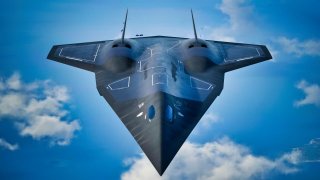Russia's MiG-41 Fighter Could Hit Mach 4 (Or Never Fly At All)
The MiG-41, also known as PAK DP, is Russia’s proposed sixth-generation stealth fighter, expected to reach speeds of Mach 4 and operate in non-permissive environments. This ambitious project combines new technology and stealth, similar to the U.S. Air Force’s B-21 Raider bomber.
What You Need to Know: The MiG-41, also known as PAK DP, is Russia’s proposed sixth-generation stealth fighter, expected to reach speeds of Mach 4 and operate in non-permissive environments. This ambitious project combines new technology and stealth, similar to the U.S. Air Force’s B-21 Raider bomber.
-However, skepticism surrounds the project due to past failures like the Su-57 Felon and T-14 Armata tank, both plagued by production and operational issues.
-As the MiG-41 remains in the design phase, Russian aerospace claims about its capabilities should be taken cautiously, especially given the underperformance of Russia’s military equipment in Ukraine.
MiG-41: The Challenges Facing Russia’s Next-Generation Fighter Jet
The war in Ukraine has revealed the great weaknesses of the Russian military and its equipment. The fighting has shown Western weapons systems are superior to their Russian counterparts, and Moscow is trying to bring new weapons into its arsenal in the coming years to improve its military’s performance. The proposed MiG-41 fighter jet is one of Russia’s most ambitious projects.
The aircraft is still under design, so not much is definitively known about the MiG-41. What follows is a breakdown of the capabilities the aircraft might have, and some thoughts on the Russian aerospace and defense industry.
MiG-41: Speed and Stealth
Also known as PAK DP, the MiG-41 is a proposed sixth-generation stealth fighter jet expected to make its maiden flight next year. The Russian Aerospace Forces are looking for an aircraft that would be able to hit high speeds – current talk estimates Mach 4, or over 3,000 miles per hour – and operate at very high altitudes.
The Russian Aerospace Forces’ desire for a fighter jet able to operate in a non-permissive airspace is in line with developments in other major air forces. Take for example the U.S. Air Force’s new bomber, the B-21 Raider. The strategic bomber is designed to penetrate enemy air defenses and deliver conventional and nuclear munitions in non-permissive environments. There are two main ways to achieve that: speed and stealth.
If an aircraft is too fast to be intercepted, it can penetrate a potent air defense umbrella. The SR-71 Blackbird is the best example of an aircraft that was simply too fast for enemy fighter jets and air defense missiles. If an aircraft can hide its signature through stealth technology, then it can also avoid interception, or at least delay it. The F-35 Lightning II stealth fighter jet is a good example of such an aircraft.
It is extremely difficult to combine speed and stealth into one aircraft. One might argue that it would be redundant to try, since either one would suffice. The fact that the Russian aerospace and defense industry is trying to do so in the form of the MiG-41 suggests grand designs for the new aircraft.
However, judging from the previous performance of Russian “wonder weapons” like the Su-57 Felon fighter jet and T-14 Armata main battle tank, Russian officials are likely setting the bar too high.
The Su-57 was touted as a fifth-generation stealth fighter, but it is still facing serious production issues and hasn’t played any meaningful part in the conflict in Ukraine.
Similarly, although years in development, the T-14 Armata main battle tank hasn’t seen any real action in the war, despite Russia losing over 2,000 tanks. The program might even be completely canceled after recurring technological issues prevented the T-14 Armata from any participation outside of a parade.
So when Russian officials talk about the MiG-41 and reference speeds beyond Mach 4, their statements should be taken with a hefty handful of salt.
About the Author:
Stavros Atlamazoglou is a seasoned defense journalist specializing in special operations and a Hellenic Army veteran (national service with the 575th Marine Battalion and Army HQ). He holds a BA from the Johns Hopkins University and an MA from the Johns Hopkins’ School of Advanced International Studies (SAIS). His work has been featured in Business Insider, Sandboxx, and SOFREP.
All images are Creative Commons.


